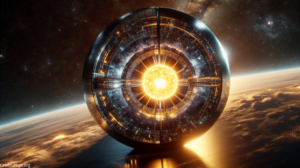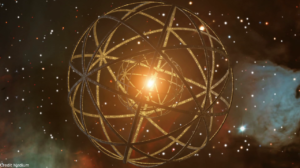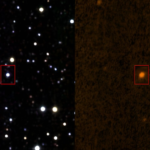Following the third strategy, a group of astronomers looked over data from recent astronomical surveys and found seven potential extraterrestrial megastructures, or Dyson spheres, “deserving of further analysis.” The Monthly Notices of the Royal Astronomical Society periodical publishes their findings.
Astronomers report possible extraterrestrial structure candidates and data that refutes the possibility of Dyson spheres.
This is an extensive research searching the stars for “oddballs”—items that could be megastructures built by aliens. The writers take care not to exaggerate anything, though. “M-dwarfs” are a class of stars that are smaller and less brilliant than the sun. The seven objects are all within 1,000 light-years of Earth.

A sophisticated society may use Dyson spheres, which scientist Freeman Dyson first envisioned in 1960 as a means of utilizing a star’s energy. Eventually, they would encircle nearly the entire star in the shape of a sphere, made up of factories, dwellings, and floating power collectors.
Dyson came to the conclusion that there will be an identifiable mark left by these megastructures.
An appreciable excess of infrared radiation is Dyson’s signature, which the team looked for in the most recent investigation. This is due to the fact that megastructures would be unable to fully use the visible light that the star would emit. Rather, they would have to “dump” extra energy as a considerably longer wavelength of infrared light.

Regretfully, this type of light can also indicate a multitude of other entities, such a gas and dust disk or comet and other debris disks. However, because the seven promising candidates did not fit well into disk models, they are not clearly caused by a disk.
The fact that the star’s visible light lowers as the megastructure moves in front of it is additional indication that the Dyson sphere exists. Similar signatures have been discovered previously. Tabby’s star (Kic 8462852) generated a lot of interest since it had several extremely odd light dips that might be caused by an extraterrestrial megastructure.
Most likely, this isn’t an extraterrestrial megasystem. There have been several natural theories put out, like comet clouds traveling through dust clouds. It is, nevertheless, a peculiar observation. Naturally, one would want to check for this signature in addition to the seven candidates.
Dyson spheres’ legal case
Still, it’s possible that Dyson spheres don’t actually exist. Their presence seems improbable, in my opinion. Not that they couldn’t exist; rather, it’s more likely that no culture advanced enough to construct them would have needed to (unless it was some kind of massive artwork).

Dyson conjectured that evolved civilizations would need enormous amounts of electricity, which is why he was exploring megastructures of this kind. Around the same period, astronomer Nikolai Kardashev devised a scale based almost exclusively on power usage to assess the progress of civilizations.
That was kind of understandable in the 1960s. They simply extrapolated this always growing need into the future since, historically, mankind has merely maintained using power at an exponential rate as both the number of people and technological advancements have occurred.
But for the past 50 years, and particularly in the last ten years, the amount of energy we use worldwide has begun to expand much more slowly. Moreover, Dyson and Kardashev never explained the purpose of these enormous amounts of power; instead, they assumed (very correctly) that they would be required to carry out whatever it is that highly developed extraterrestrial civilizations perform.
Nevertheless, efficiency, downsizing, and nanotechnologies promise much reduced power consumption in the future (pretty much every technology continuously improves in terms of performance per watt).
A short calculation tells us that we would require a surface area equivalent to one billion Earths if we were to harvest 10% of the sun’s energy at the distance that the Earth is from the sun.
Furthermore, we would require almost a million Earths’ worth of material to construct the megastructure if we possessed extremely sophisticated technology that allowed it to be only 10 km thick.
Read More Articles
What will happen to US stock market on Memorial Day in 2024? Understand the trading schedule.
No. 11 LSU is ecstatic as they prepare for a best-of-three series against No. 8 Stanford.
Microsoft redesigned Windows 11 with Arm and AI chips in mind.
The fact that there are only 100 Earths’ worth of solid material in our solar system presents a serious challenge: in order to construct their Dyson sphere, our advanced extraterrestrial civilization would have to disassemble every planet into 10,000 planetary systems and transfer the components to the star.
Each component of the megastructure could only be one meter thick in order to accomplish this with the material available in a single system. This is presuming that they make use of every element found in a planetary system.
We would have to destroy millions of planetary systems in order to obtain carbon if they need, say, a large amount of it to build their structures. While it is a formidable task, I’m not ruling out the possibility that a highly developed extraterrestrial society may accomplish it.
Furthermore, if a civilization managed to develop a Dyson sphere by then, I have a strong suspicion that they would have found a more efficient means of obtaining energy than relying on stars, given their sophisticated technological capabilities.










